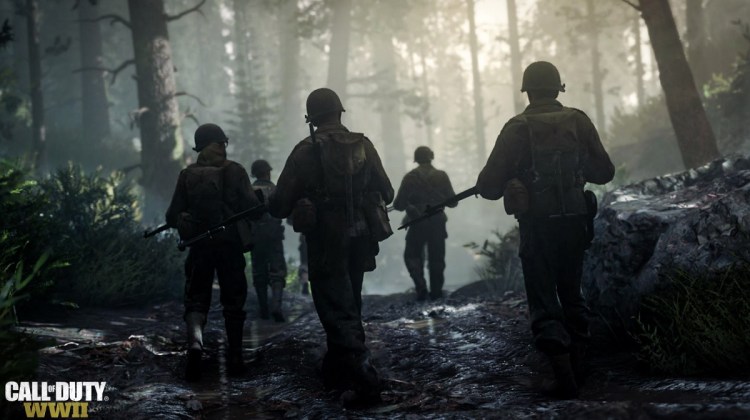Michael Condrey, studio head and cofounder of Sledgehammer Games, has just completed a three-year march to take Call of Duty back to the Second World War. Condrey and his co-studio head Glen Schofield led a team of 300 developers at Sledgehammer and another 200 elsewhere at Activision to complete Call of Duty: WWII, the reboot of the first-person shooter series that returns the game to infantry combat.
Getting the reboot right is important. The franchise has sold more than 250 million units and $15 billion in sales since 2003. On average, that is more than 17 million units and $1 billion worth sold per year. Selling any less than that in a given year is considered a failure, according to Michael Pachter, an analyst at Wedbush Securities. Call of Duty: Infinite Warfare and Call of Duty: Ghosts were weak performers. At the high end of the spectrum was Call of Duty: Black Ops III, which sold 26 million units, and Sledgehammer’s own previous title, Call of Duty: Advanced Warfare, sold 22 million units, Pachter said.
(Here’s our other coverage of Call of Duty: WWII).
That gives you an idea of the kind of pressure Sledgehammer is under. The team immersed themselves in history, and their game, Call of Duty: WWII, debuts today on the Xbox One, PlayStation 4, and PC. The title has a single-player campaign that tracks a squad from the Fighting First, the 1st Infantry Division that saw so much action from D-Day on Omaha Beach to the crossing of the Rhine. Sledgehammer puts the player into the thick of the action in a return to “boots-on-the-ground” infantry combat.
June 5th: The AI Audit in NYC
Join us next week in NYC to engage with top executive leaders, delving into strategies for auditing AI models to ensure fairness, optimal performance, and ethical compliance across diverse organizations. Secure your attendance for this exclusive invite-only event.
Gone are the flying jumps from the sci-fi versions of the game. Now the game focuses on the story of a squad of soldiers fighting against the odds in a campaign that spans the full horror of the war. The game also has huge multiplayer and Zombies modes, as well as a new Headquarters social hub. I played all parts of the game at a review event and interviewed Condrey about what it took to get the job done.
Here’s an edited transcript of our interview.
Editor’s note: This story has narrative spoilers.

Above: Michael Condrey, studio head and cofounder of Sledgehammer Games.
GamesBeat: I’m looking at the Call of Duty poster. Is that a picture of you after three years of development?
Michael Condrey: (Laughs). They say that war brings out the best and the worst in people. I’m sure at some point in development it brought out both in me.
It’s interesting, though. When we started the campaign, we found these images of these young soldiers who went to war, and for soldiers who landed on Normandy in June of 1944, they were in combat something like — I can get the actual stats for you, but our military advisor was saying they only saw combat maybe three days out of a month. But they were still in the field in these harsh conditions. After 18 months overseas they’d come back looking like they’d aged a decade. This image was meant to capture that stare of a kid who’s gone to war and seen some rough things.
But for us it’s been a great three years. We put a lot into this one. We’re ready to share it with the world, that’s for sure.
GamesBeat: He’s looking at the squad as well. The story of the squad was an interesting one. It seems like you had a chance to develop a lot of characters and tie them together.
Condrey: It’s a more personal story, absolutely. The last episode of Band of Brothers, after you’ve watched Captain Winters and his crew, you get to meet the real Captain Winters, documentary style. He’s sitting on a couch being interviewed, and at one point he tells a story. He says, “My granddaughter asked me what it was like to be a hero in World War II.” This 70-year-old version of Captain Winters starts to cry and says, “I told my granddaughter I wasn’t a hero, but I served in the company of heroes.”
This man, by all accounts, was a hero. And yet 50 years after the war he doesn’t see himself as a hero. He considers the people around him, the camaraderie, the squad. It’s a sentiment I find very powerful. Our story was really about that. It wasn’t about the individual, a single protagonist played by a recognizable actor. It was about the camaraderie of men under extraordinarily harsh circumstances and what they did together. The squad becomes the center of it.
GamesBeat: Is that why you went with relatively unknown actors, then?
Condrey: We looked for performances first. We needed and wanted actors who could deliver these emotions. Josh Duhamel is known, and he did a phenomenal job with his character, but—this was not meant to highlight an individual soldier’s journey. All those arcs are powerful and important.

Above: Private Robert Zussman in Call of Duty: WWII.
GamesBeat: The campaign features about a dozen battles. I’m curious how you chose some of the characteristics of the scenes you focused on. It seems like a lot of them were the worst things that could possibly happen to an infantryman.
Condrey: First, we wanted to tell a story that was based on true events. We wanted to find a journey that emotionally resonated in the European theater. The First Infantry gave us that. Our squad is an original story within that. The First Infantry was 15,000 troops, so under that Big Red One umbrella, this is an original sort of tale.
Call of Duty is known for some big events, some impactful moments. I think when we first started researching the game, especially coming off Advanced Warfare, where we had the opportunity to do some pretty incredible set pieces — we began by looking at where we could deliver that level of action in a Call of Duty style that was authentically representative of the conflict. Thankfully, we found plenty of opportunities.
D-Day is iconic. It really anchors the Allied invasion. Cobra, which was a huge battle. The liberation of Paris. The destruction of Aachen. This really happened. We found these big set pieces that were based on what really happened in the war. But then we also wanted to juxtapose that against these choir moments, more tense moments, more personal moments. The big moments came about naturally through the massive conflict of the war.
Working with our military advisor, Marty Morgan, as we started to craft the narrative, it was easy. We would go to him and say, “We’re trying to get the First Infantry from here to here. We’d like to introduce the French Resistance. We’d like to show an ensemble cast. We’d like to show more than just an American story. What could we do for that?” “Oh, I’ve got the perfect idea. This happened here.” He was great about helping us take the creative arc we were trying to do in the story and then marrying that to what happened in the war.
Beyond that, he took us to these places. We talked about this before. We got to go to Aachen and feel the weight of that battle. It’s been quite a journey. Hopefully you felt that, some highs and lows. Big moments like Normandy, and some dark, personal moments. Zussman’s story, his rescue, those are — hopefully you felt that, some real emotion along that journey. They work well together.
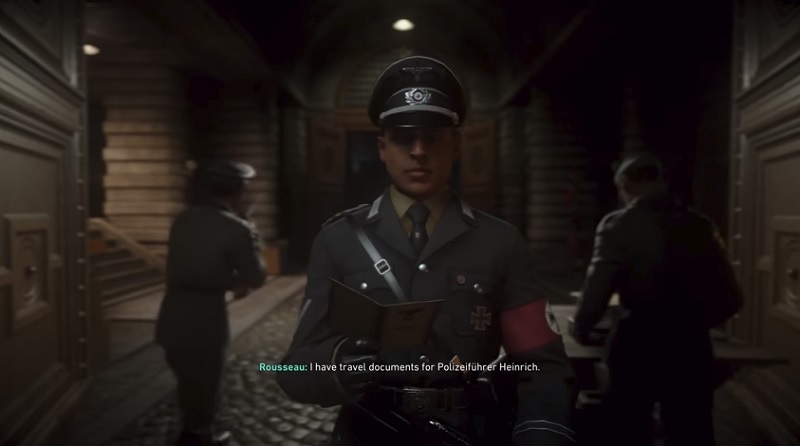
Above: The French Resistance mission requires stealth.
GamesBeat: Zussman’s story seems to remind people of why the Allies are fighting the war. It shows this prejudice against Jews at the beginning of the conflict that wouldn’t necessarily come into a combat story.
Condrey: World War II, in some ways, is a bit faded from consciousness now. It’s been almost 80 years. Hitler’s genocide didn’t start with Jews. It started with his own people. It started with cripples and the elderly, in his own country, and then it spread. By the time it was over the genocide was atrocious, and there were a lot of countries and a lot of individuals complicit in that. So yeah, do you tell the story that it will never happen again? Absolutely. You tell the story because those who fought so it wouldn’t happen again can’t tell it for themselves.
GamesBeat: There’s this subtext of prejudice on the American side as well, and within the unit itself.
Condrey: That’s absolutely true. We wrestled with that quite a bit throughout development, trying to figure out the right balance of showing what was happening in the war, with the Nazis and their iconography and the language around what was happening with the genocide, without glorifying it. Knowing that this destruction and death happened, we couldn’t shy away from it.
At the same time we have to recognize what was happening in our own country in the ‘40s, right? Racism was rampant. Segregation was part of the war. We couldn’t be authentic to these challenges if we looked away from that as well.

Above: The landing at Omaha Beach in Call of Duty: WWII.
GamesBeat: The enemy isn’t entirely demonized, though, not to the usual video game extreme.
Condrey: It’s true. It’s easy to demonize the Nazis. It’s like you say about the best and the worst of humanity. There were plenty of German soldiers fighting in what they thought was a patriotic cause, who weren’t Nazis. I’m sure you’ve heard stories of soldiers meeting in town on Christmas and sharing a meal together. There are examples of the best of humanity on both sides. We didn’t want to paint every Axis soldier as a Nazi. That wouldn’t have been right either. But I don’t think we held back on showcasing how evil the Nazi state of mind was.
GamesBeat: I feel like the tone changes as you go to multiplayer. It feels different. That’s almost always the case with a Call of Duty game. The interesting thing to me was when I first went into Headquarters. You’re greeted by someone and he talks about your career. I’m going to have a multiplayer career. I’m going to climb up the ladder and see if I can get to prestige. It’s not as much about immersion in history.
Condrey: All three modes of the game, while living in a holistic WWII wrapper, each try to deliver something unique. In the campaign, we’re committed to this rich emotional narrative, an authentic story. Multiplayer has a different goal. And certainly Nazi Zombies is way off in this fantastical story, which we love.
Multiplayer is social. We wanted to capture some of the feeling of the gritty, brutal experience. I think you see that in the core combat — the iconic locations, the arsenal of weapons. You see death and destruction. There’s a grittiness to our multiplayer that we didn’t have in Advanced Warfare. But certainly multiplayer is not intended to be historically accurate as far as narrative.
It’s as competitive and social as much as it’s anything. We know that half the time when you play multiplayer you’re going to be thrown on the Axis side. That suspension of the war—the setting is really immersive. The backdrops feel as immersive as the campaign. But the factions, while you’re playing Axis or Allied, are meant to be you in the war.
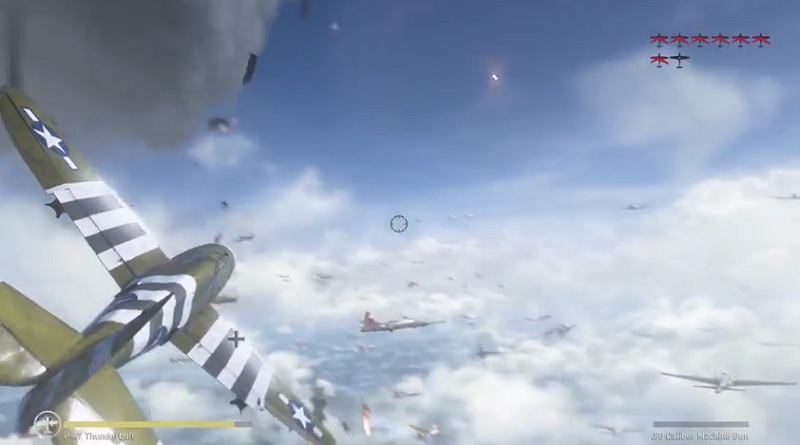
Above: It’s not all boots on the ground in Call of Duty: WWII.
GamesBeat: The player is still immersed, but they’re immersed in something different.
Condrey: In a similar way, Nazi Zombies is a great story. We loved telling it. As you can imagine, because you’re well-versed in the franchise, there’s nothing authentic about Nazi Zombies. It’s a story about the Monuments Men looking for stolen art and finding something very different. But it’s allowed to express that in a completely different way.
GamesBeat: It seems like this is the way you’re at the most creative. You’re constructing something that doesn’t have to follow any historical guidelines.
Condrey: It’s the most unrestrained as far as our ability to be fantastical, if you will. I don’t know if it’s the right word to describe it. But I love the overarching story of, the Monuments Men go to Germany to find stolen art and they find the Nazis raising an army of the dead instead. And then from there, what does that mean? Well, it means whatever you can imagine. It feels right, because we’re not trying to make it about the history of the war.
But yes, you’re right. Each mode has certain things it brings that marry well to what we’re trying to accomplish. Multiplayer isn’t about the authenticity that campaign has, even though it’s authentic and believable in many ways.
GamesBeat: In that sense, maybe people who are looking the game should understand the context behind each part of it? You can’t really criticize multiplayer on its historical accuracy.
Condrey: Certainly not. And hopefully people are familiar enough with Call of Duty to get that. The construct of the experience is — it’s meant to be fun and vast and engaging and social and competitive and all these things, but by nature—we have disembodied score streaks. We have life respawns. There’s a bunch of stuff that’s been gamified for the experience. I would no more want people to play Nazi Zombies and think we’re trying to be historically accurate than play multiplayer and want to debate why infantrymen on the ground can all of a sudden control a turret gunner with a scorestreak.
But within that, I think what fans love about it—I think it does a good job of putting the player in this gritty war environment. The set pieces themselves are driven from a very believable and authentic sense. Every map you’ve seen is a place we went to.
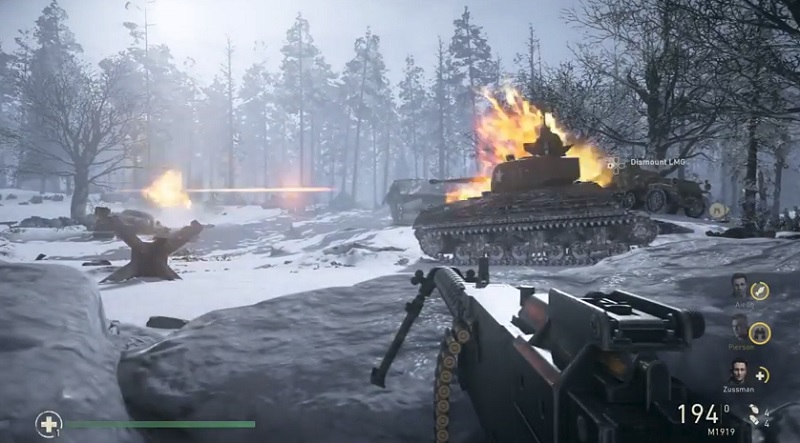
Above: The Battle of the Bulge in Call of Duty: WWII.
GamesBeat: It seems like there might be a bit of a common thread in — going back to WWII slows the action down. It’s not jumping across the map. You have limitations again. If you see something in the distance you have to run there. Going from WWII to science fiction sped the game up enormously, and now you’re back to a slower pacing.
Condrey: I think that pace really adds to our experience. It adds strategy. You feel like you understand your threats and threat lanes. You feel like you’re able to master the setup that’s to come. I’m proud of what we did on Advanced Warfare, but I haven’t used a sniper rifle in multiplayer in three years. It was just too fast for me. Maybe I’m old. Maybe all of the thrust and boost movement — I wasn’t able to get up to the speed I needed to be at to feel competitive. But now I feel that again, and it’s great, that return-to-the-roots experience. It feels right for this game.
GamesBeat: Plenty of things in here are satisfying for a gamer like me. Do you think this game still has enough for the expert gamer?
Condrey: Absolutely. One thing we always talk about is this idea of “easy to pick up and hard to master.” On Advanced Warfare, maybe we moved away from the “easy to pick up” part and made it harder to master. In this game we have a rich progression. We have weapon progression, division progression, player progression. You have some really unique and interesting multiplayer experiences, like War mode. In Headquarters you want to be the best of the best on the firing range.
I have no doubt that we have avenues for people who are looking to showcase that they’re the most proficient, most skilled. They’ll absolutely find that. We have Raymond Lussier on our team, an ex-champion in Call of Duty esports. He still amazes me with how he can learn to be the best of the best in these games. There’s no slowing down for him. He’s always looking for that edge. So yeah, absolutely. For newcomers, for mid-core guys like you and I — we’ve played a lot, but we’ll never be esports competitors — I think you’ll find all of those.
GamesBeat: Some of the most fun I’ve had is in War mode. It’s an interesting change.
Condrey: What I love about War — when we first prototyped that, we were trying to address this idea that, over the years, Call of Duty multiplayer had become about a lone wolf experience. Even in objective modes that were supposed to be team-based, you weren’t really playing the objectives that much. It was about your K/D. Then you realized that at the heart of your experience, the K/D is the reason. People optimize for the highest K/D, and by extension for bragging rights and the ability to get high-end scorestreaks and all that.
It’s coming back to this idea that it’s about the squad, the greater good of the squad. We wanted to offer a mode that felt like a big war, that felt like you were a critical part of the squad. The first thing we did was remove K/D as a thing you really cared about. Then we prototyped modes that would continue to reinforce this idea that you have to survive and work together on these really critical objectives. I think you feel it now. It’s frenetic and fun, it feels like big action, but it reinforces this idea that—if you play the lone wolf in War you’re not going to do very well, and your team’s not going to do well.
Of course, it has these high drama points. You’re never really out of the fight. The last 10 seconds, right? Have you ever gone into overtime?
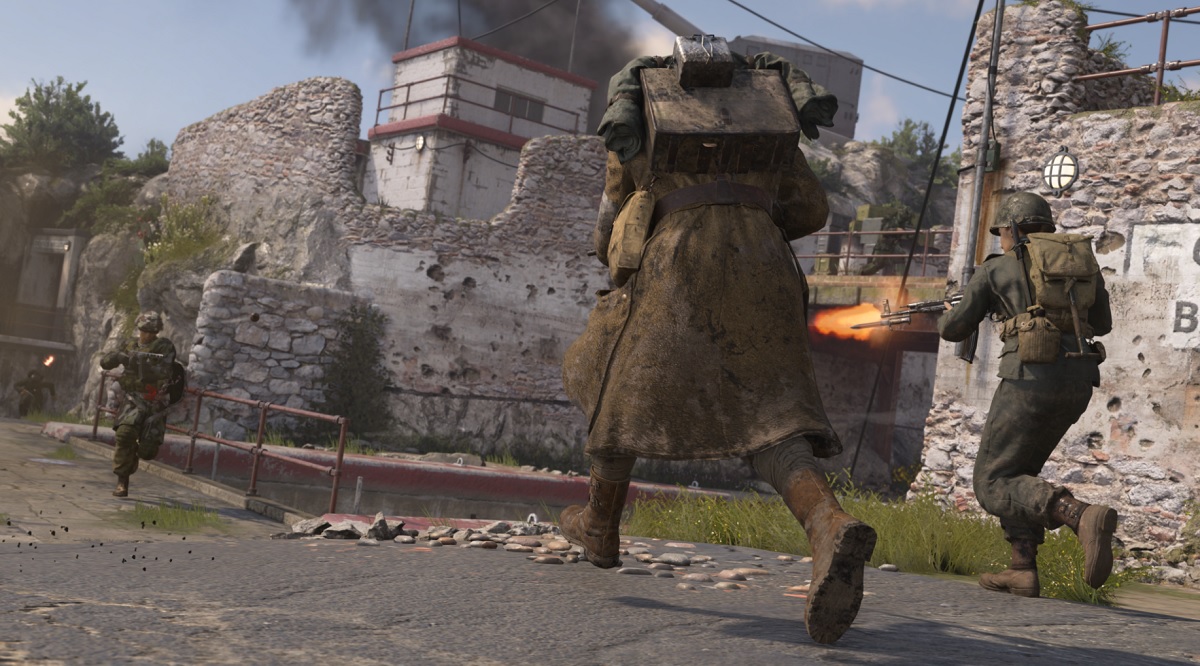
Above: The Sledgehammer team visited Gibraltar to get the layout right.
GamesBeat: When you’re not into overtime but just at the end of the bridge in the snowy one.
Condrey: Yeah, that one’s great. Same thing with Breakout. I’ve been at 98 percent and it goes to overtime and you’re getting that last tug of war—I’ve been on both sides. We finally got it over, or they stopped us at two percent short. It’s dramatic and it’s fun.
We’re enjoying War, and we have a lot to offer in November. Those three modes are really compelling. They’re rich in terms of what they offer. Of course, if fans respond the way we expect, we’ll bring more to War mode in the months ahead. We have the competitive modes that people love – TDM, Domination, Hardpoint, Gridiron, those are all great. Headquarters hopefully transforms the social space. There’s a lot there.
GamesBeat: I liked the maps where I figured out something to do, a role for myself. What’s the Battle of the Bulge one called?
Condrey: It’s called Operation Griffin.
GamesBeat: I liked that because just manning the machine gun and standing guard is something you can do. Anyone that comes into view, shoot them.
Condrey: There’s a strategy of knowing — okay, you get the high ground with the machine gun, and then you have two people going left. We’re watching how people are going to implement different strategies there. It’s fun to be able to grab that one place where you can really make a difference, as opposed to just being cannon fodder.
GamesBeat: The building-the-bridge one, too, I would go off to the left and shoot at the guys who were sniping down toward the bridge. I figured out that my light machine gun could shoot through the walls at them.
Condrey: That was an important component in War, giving everybody a role. Guaranteed, when you were back there in that machine gun nest, you were helping your team be successful. If everyone was just optimized for their own K/D and running around, you’re not going to be successful in War mode.
Call of Duty: WWII is available on November 3 for the PC, Xbox One, and Playstation 4. The publisher provided GamesBeat with a copy of PS4 edition of the game for this review, and I attended a review event.
